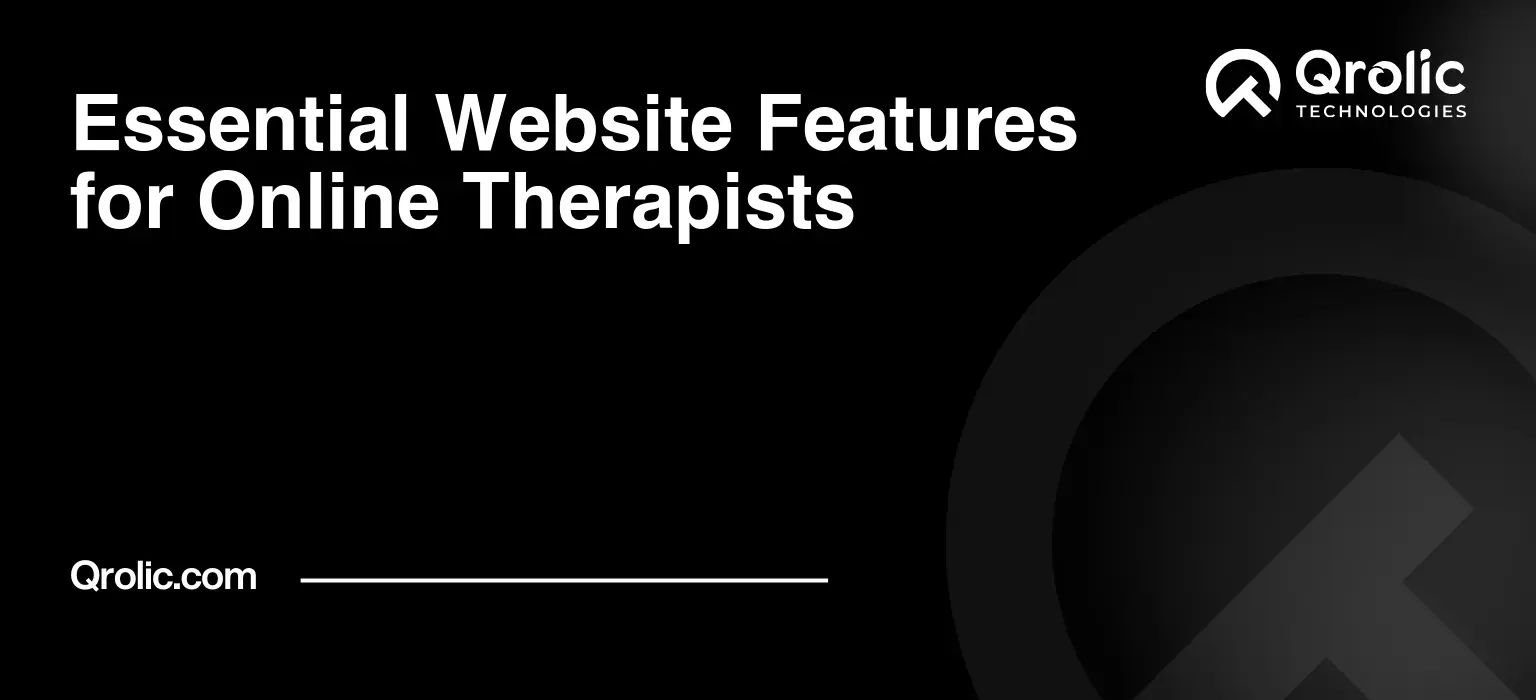Quick Summary:
- Design a professional, trustworthy, and mobile-friendly website.
- Offer secure online booking and video sessions for clients.
- Create valuable content and optimize for search engines.
- Ensure website security with SSL certificates and backups.
Table of Contents
- 1. Building Trust and Authority: Your Digital First Impression
- 1.1. Professional Design: Projecting Competence and Care
- 1.2. Compelling “About Me” Section: Showcasing Your Expertise and Personality
- 1.3. Client Testimonials and Reviews: Social Proof and Validation
- 2. Streamlining the Client Journey: Booking and Communication
- 2.1. Online Appointment Booking: Convenience and Accessibility
- 2.2. Secure Video Conferencing Integration: Delivering Remote Therapy
- 2.3. Contact Form and Communication Channels: Accessibility and Responsiveness
- 3. Enhancing User Experience: Content and Navigation
- 3.1. Informative and Engaging Content: Providing Value and Expertise
- 3.2. Clear and Intuitive Navigation: Guiding Visitors to Key Information
- 3.3. Accessibility Considerations: Ensuring Inclusivity
- 4. Search Engine Optimization (SEO): Attracting New Clients Online
- 4.1. Keyword Research: Identifying Relevant Search Terms
- 4.2. On-Page Optimization: Optimizing Your Website Content
- 4.3. Off-Page Optimization: Building Authority and Backlinks
- 5. Website Security and Maintenance: Protecting Your Clients and Your Business
- 5.1. SSL Certificate: Ensuring Data Encryption
- 5.2. Regular Backups: Protecting Against Data Loss
- 5.3. Security Plugins and Updates: Preventing Cyberattacks
- 6. Qrolic Technologies: Your Partner in Building a Successful Online Presence
1. Building Trust and Authority: Your Digital First Impression
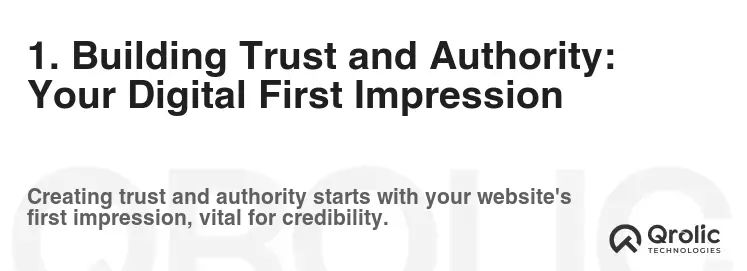
1.1. Professional Design: Projecting Competence and Care
Your website is often the first interaction a potential client has with you. A professional design isn’t just about aesthetics; it’s about conveying competence, trustworthiness, and empathy. Think of it as the digital equivalent of a well-maintained and welcoming office.
- Why it Matters: First impressions are crucial. A poorly designed website can instantly deter potential clients, leading them to believe your services might be unprofessional or outdated. A clean, modern design, on the other hand, instills confidence and encourages exploration.
- Key Elements of a Professional Design:
- Clean Layout: Avoid clutter. Use whitespace effectively to create a visually appealing and easy-to-navigate experience.
- High-Quality Images: Use professional photos of yourself and your practice, or carefully selected stock photos that evoke feelings of calm and security. Avoid generic or low-resolution images.
- Consistent Branding: Maintain a consistent color palette, font choices, and overall style across your entire website to reinforce your brand identity.
- Mobile Responsiveness: Ensure your website looks and functions flawlessly on all devices (desktops, tablets, and smartphones). Mobile users are a significant portion of online traffic.
- User-Friendly Navigation: Make it easy for visitors to find the information they’re looking for. A clear and intuitive navigation menu is essential.
- Examples of Effective Designs:
- Websites that use calming colors (blues, greens, soft yellows) and natural imagery.
- Websites with clear calls to action, such as “Schedule a Consultation” or “Learn More.”
- Websites that highlight testimonials and client reviews prominently.
1.2. Compelling “About Me” Section: Showcasing Your Expertise and Personality
The “About Me” section is your opportunity to connect with potential clients on a personal level. It’s where you showcase your expertise, highlight your experience, and share your personality.
- Why it Matters: Potential clients want to know who you are, what your qualifications are, and why they should trust you with their mental health. A well-crafted “About Me” section can build rapport and encourage them to reach out.
- Key Elements of a Compelling “About Me” Section:
- Credentials and Qualifications: Clearly state your degrees, licenses, certifications, and areas of specialization.
- Experience: Highlight your relevant experience in the field of therapy, including years of practice, specific populations you’ve worked with, and any notable achievements.
- Personal Statement: Share your approach to therapy, your philosophy, and what you’re passionate about. This is where you can let your personality shine through and connect with potential clients on a deeper level.
- Professional Photo: Include a high-quality, professional photo of yourself.
- Easy-to-Read Format: Break up text into short paragraphs and use bullet points to make it easy to scan.
- Tips for Writing a Great “About Me” Section:
- Write in a conversational tone.
- Focus on the client’s needs and how you can help them.
- Be authentic and genuine.
- Proofread carefully for errors.
1.3. Client Testimonials and Reviews: Social Proof and Validation
Testimonials and reviews are powerful tools for building trust and credibility. They provide social proof that your services are effective and that you’re a reliable and compassionate therapist.
- Why it Matters: Potential clients are more likely to trust the opinions of others than they are to trust your own self-promotion. Testimonials and reviews offer unbiased feedback that can help them make an informed decision.
- Strategies for Gathering Testimonials and Reviews:
- Ask for them: After a successful therapy session or at the end of treatment, politely ask clients if they would be willing to provide a testimonial.
- Make it easy: Provide clients with a template or a link to a review platform.
- Highlight positive feedback: Prominently display positive testimonials and reviews on your website.
- Use a variety of formats: Include written testimonials, video testimonials, and reviews from online platforms.
- Tips for Using Testimonials Effectively:
- Obtain consent before publishing testimonials.
- Anonymize testimonials if necessary to protect client confidentiality.
- Use real testimonials from real clients.
- Include a photo or name of the client (with their permission).
2. Streamlining the Client Journey: Booking and Communication
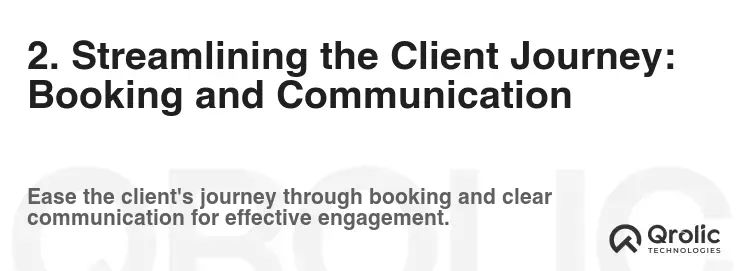
2.1. Online Appointment Booking: Convenience and Accessibility
Offering online appointment booking is a game-changer for both you and your clients. It provides convenience, accessibility, and efficiency, making it easier for clients to schedule appointments and for you to manage your calendar.
- Why it Matters: Online appointment booking eliminates the need for phone calls and emails, saving time and reducing administrative burden. It also allows clients to book appointments at their convenience, 24/7.
- Essential Features of an Online Appointment Booking System:
- Calendar Integration: Seamless integration with your existing calendar (Google Calendar, Outlook, etc.) to avoid double-booking.
- Customizable Availability: Ability to set your available hours, block off time for breaks, and manage your schedule.
- Appointment Reminders: Automated email and SMS reminders to reduce no-shows.
- Payment Processing: Integration with payment gateways to allow clients to pay for appointments online.
- Client Management: Tools for managing client information, appointment history, and communication preferences.
- Benefits of Online Appointment Booking:
- Increased Efficiency: Reduces administrative tasks and frees up time for other activities.
- Improved Client Satisfaction: Provides a convenient and accessible booking experience.
- Reduced No-Shows: Automated reminders help clients remember their appointments.
- Enhanced Revenue: Easier booking leads to more appointments and increased revenue.
- Choosing the Right Online Appointment Booking System:
- Consider your specific needs and budget.
- Look for a system that is easy to use and integrates with your existing tools.
- Read reviews and compare features before making a decision.
2.2. Secure Video Conferencing Integration: Delivering Remote Therapy
Secure video conferencing integration is essential for online therapists. It allows you to deliver therapy sessions remotely, providing clients with access to your services from the comfort of their own homes.
- Why it Matters: Video conferencing expands your reach and allows you to serve clients who may not be able to attend in-person sessions due to geographical limitations, mobility issues, or other constraints.
- Key Features of a Secure Video Conferencing Platform:
- End-to-End Encryption: Ensures that all communication between you and your client is private and secure.
- HIPAA Compliance: Adherence to HIPAA regulations to protect client confidentiality.
- Reliable Connection: Stable and reliable video and audio quality.
- Screen Sharing: Ability to share your screen with clients for presentations or other therapeutic activities.
- Recording Capabilities: Option to record sessions (with client consent) for review or training purposes.
- Popular Video Conferencing Platforms for Online Therapists:
- Zoom for Healthcare
- Doxy.me
- TheraPlatform
- SimplePractice
- Tips for Delivering Effective Video Therapy Sessions:
- Ensure a quiet and private environment.
- Use a high-quality webcam and microphone.
- Maintain eye contact with the client.
- Be mindful of your body language.
- Offer clear instructions and technical support.
2.3. Contact Form and Communication Channels: Accessibility and Responsiveness
A well-designed contact form and clear communication channels are essential for making it easy for potential clients to reach out to you. Accessibility and responsiveness are key to building trust and converting inquiries into clients.
- Why it Matters: A readily available contact form and clear communication channels demonstrate that you are accessible and responsive to potential clients’ needs.
- Essential Elements of a Contact Form:
- Name: Allows you to personalize your response.
- Email Address: Essential for communication.
- Phone Number (Optional): Provides an alternative means of contact.
- Message Box: Allows potential clients to describe their needs and concerns.
- CAPTCHA: Prevents spam submissions.
- Privacy Policy Link: Ensures compliance with data privacy regulations.
- Other Communication Channels:
- Phone Number: Display your phone number prominently on your website.
- Email Address: Provide a dedicated email address for inquiries.
- Live Chat (Optional): Offers real-time support and assistance.
- Tips for Effective Communication:
- Respond to inquiries promptly (within 24-48 hours).
- Be professional and courteous in your communication.
- Provide clear and concise information.
- Offer a free consultation to assess client needs.
3. Enhancing User Experience: Content and Navigation
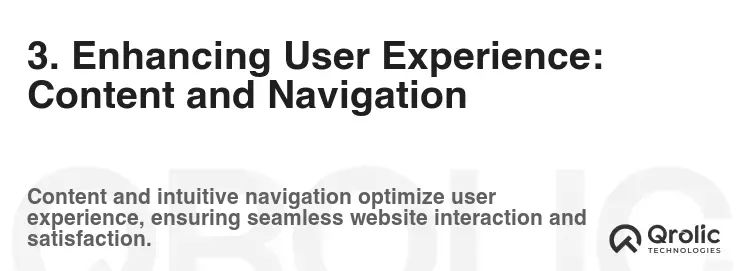
3.1. Informative and Engaging Content: Providing Value and Expertise
High-quality content is the cornerstone of a successful website. It provides value to potential clients, establishes you as an expert in your field, and improves your search engine ranking.
- Why it Matters: Informative and engaging content attracts visitors to your website, keeps them engaged, and encourages them to take action.
- Types of Content to Include:
- Blog Posts: Share your insights, tips, and advice on various mental health topics.
- Articles: Write in-depth articles on specific conditions or treatment approaches.
- FAQ Section: Answer frequently asked questions about your services, fees, and policies.
- Resources Page: Provide links to helpful websites, books, and articles.
- Videos: Create videos that introduce yourself, explain your services, or offer tips on mental wellness.
- Podcast (Optional): Share your expertise through audio content.
- Tips for Creating Engaging Content:
- Write in a clear and concise style.
- Use headings, subheadings, and bullet points to break up text.
- Include images and videos to enhance visual appeal.
- Optimize your content for search engines (see section 4).
- Promote your content on social media.
3.2. Clear and Intuitive Navigation: Guiding Visitors to Key Information
Easy navigation is essential for a positive user experience. Visitors should be able to find the information they’re looking for quickly and easily.
- Why it Matters: A confusing or cluttered website can frustrate visitors and drive them away. Clear and intuitive navigation ensures that visitors can easily find the information they need, increasing the likelihood that they will contact you.
- Key Elements of Clear Navigation:
- Simple Menu Structure: Limit the number of menu items and use clear and descriptive labels.
- Logical Organization: Group related pages together under appropriate menu headings.
- Consistent Navigation: Maintain the same navigation menu on every page of your website.
- Search Functionality: Provide a search bar to allow visitors to quickly find specific information.
- Breadcrumbs: Use breadcrumbs to show visitors their location within the website.
- Mobile-Friendly Navigation: Ensure that your navigation is easy to use on mobile devices.
- Tips for Improving Navigation:
- Test your navigation with users to identify areas for improvement.
- Use analytics to track how visitors are using your website.
- Keep your navigation up-to-date.
3.3. Accessibility Considerations: Ensuring Inclusivity
Accessibility is about making your website usable by everyone, including people with disabilities. It’s not just a matter of compliance; it’s about ensuring inclusivity and providing equal access to your services.
- Why it Matters: Ignoring accessibility can exclude potential clients and limit your reach. By making your website accessible, you can demonstrate your commitment to inclusivity and provide a better experience for all users.
- Key Accessibility Considerations:
- Alternative Text for Images: Provide descriptive alt text for all images to allow screen readers to convey the image’s content to visually impaired users.
- Keyboard Navigation: Ensure that all website elements can be accessed and operated using a keyboard.
- Color Contrast: Use sufficient color contrast between text and background to make it easier for people with visual impairments to read.
- Font Size and Readability: Use a font size that is easy to read and allow users to adjust the font size.
- Captions and Transcripts for Videos: Provide captions and transcripts for all videos to make them accessible to deaf and hard-of-hearing users.
- Semantic HTML: Use semantic HTML elements (e.g.,
<header>,<nav>,<article>,<footer>) to structure your content in a way that is meaningful to screen readers.
- Tools for Checking Accessibility:
- WAVE Web Accessibility Evaluation Tool
- Accessibility Insights
- Lighthouse (Google Chrome Developer Tools)
4. Search Engine Optimization (SEO): Attracting New Clients Online

4.1. Keyword Research: Identifying Relevant Search Terms
Keyword research is the foundation of any successful SEO strategy. It involves identifying the terms and phrases that potential clients are using to search for online therapists.
- Why it Matters: By targeting the right keywords, you can increase your website’s visibility in search results and attract more qualified leads.
- Tools for Keyword Research:
- Google Keyword Planner
- SEMrush
- Ahrefs
- Moz Keyword Explorer
- Types of Keywords to Target:
- Informational Keywords: Keywords that people use to find information about mental health conditions or treatment options (e.g., “what is anxiety,” “how to cope with depression”).
- Navigational Keywords: Keywords that people use to find a specific website or brand (e.g., “Dr. Smith therapy,” “MyPractice website”).
- Transactional Keywords: Keywords that people use when they are ready to take action, such as booking an appointment (e.g., “online therapist near me,” “book therapy session”).
- Tips for Keyword Research:
- Think like your potential clients.
- Use long-tail keywords (longer, more specific phrases).
- Analyze your competitors’ keywords.
- Track your keyword rankings.
4.2. On-Page Optimization: Optimizing Your Website Content
On-page optimization involves optimizing your website’s content and HTML code to improve its ranking in search results.
- Why it Matters: On-page optimization helps search engines understand what your website is about and how relevant it is to specific search queries.
- Key On-Page Optimization Factors:
- Title Tags: Create compelling and keyword-rich title tags for each page of your website.
- Meta Descriptions: Write engaging meta descriptions that encourage users to click on your search results.
- Header Tags (H1-H6): Use header tags to structure your content and highlight important keywords.
- Content Optimization: Optimize your content for your target keywords by including them naturally in your text.
- Image Optimization: Optimize your images by using descriptive file names and alt text.
- Internal Linking: Link to other relevant pages on your website to improve navigation and distribute link equity.
- URL Structure: Use descriptive and keyword-rich URLs.
- Tools for On-Page Optimization:
- Yoast SEO (wordpress plugin)
- Rank Math (WordPress plugin)
- SEMrush
- Ahrefs
4.3. Off-Page Optimization: Building Authority and Backlinks
Off-page optimization involves building your website’s authority and reputation by acquiring backlinks from other websites.
- Why it Matters: Backlinks are a signal to search engines that your website is valuable and trustworthy. The more high-quality backlinks you have, the higher your website is likely to rank in search results.
- Strategies for Building Backlinks:
- Guest Blogging: Write guest posts for other websites in your niche and include a link back to your website.
- Broken Link Building: Find broken links on other websites and offer to replace them with a link to your website.
- Resource Page Link Building: Create a valuable resource page on your website and promote it to other website owners.
- Directory Submissions: Submit your website to relevant online directories.
- Social Media Promotion: Share your content on social media to increase its visibility and attract backlinks.
- Tips for Building High-Quality Backlinks:
- Focus on acquiring backlinks from reputable and relevant websites.
- Avoid buying backlinks or participating in link schemes.
- Diversify your backlink profile.
- Monitor your backlink profile regularly.
5. Website Security and Maintenance: Protecting Your Clients and Your Business
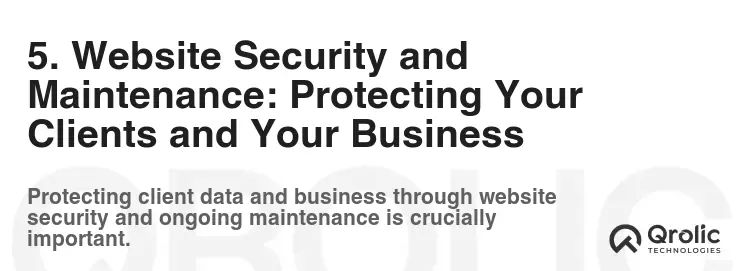
5.1. SSL Certificate: Ensuring Data Encryption
An SSL (Secure Sockets Layer) certificate is essential for protecting your clients’ data and ensuring secure communication between their browsers and your website.
- Why it Matters: An SSL certificate encrypts the data transmitted between your website and visitors’ browsers, preventing it from being intercepted by hackers. This is especially important for websites that collect sensitive information, such as personal details, payment information, and medical history.
- How to Obtain an SSL Certificate:
- Purchase an SSL certificate from a reputable provider (e.g., Let’s Encrypt, Comodo, DigiCert).
- Install the SSL certificate on your web server.
- Configure your website to use HTTPS (Hypertext Transfer Protocol Secure).
- Benefits of an SSL Certificate:
- Encrypts data to protect client privacy.
- Builds trust with clients by displaying a padlock icon in the browser address bar.
- Improves search engine ranking.
- Complies with data privacy regulations.
5.2. Regular Backups: Protecting Against Data Loss
Regular backups are crucial for protecting your website against data loss due to server crashes, hacking attacks, or accidental deletions.
- Why it Matters: Data loss can be devastating for your business, potentially causing you to lose valuable client information, content, and website functionality. Regular backups ensure that you can quickly restore your website to a working state in the event of a disaster.
- Types of Backups:
- Full Backups: Back up all of your website’s files and databases.
- Incremental Backups: Back up only the changes that have been made since the last full backup.
- Differential Backups: Back up all the changes that have been made since the last full backup, regardless of when it was performed.
- Tips for Regular Backups:
- Automate your backups to ensure that they are performed regularly.
- Store your backups in a secure location, separate from your web server.
- Test your backups regularly to ensure that they can be restored successfully.
5.3. Security Plugins and Updates: Preventing Cyberattacks
Security plugins and regular software updates are essential for protecting your website against cyberattacks.
- Why it Matters: Websites are a frequent target for hackers who are looking to steal data, inject malware, or deface websites. Security plugins and regular updates help to patch vulnerabilities and prevent hackers from gaining access to your website.
- Essential Security Plugins (for WordPress):
- Wordfence Security
- Sucuri Security
- iThemes Security
- Tips for Preventing Cyberattacks:
- Use strong passwords.
- Keep your software up-to-date.
- Install a security plugin.
- Monitor your website for suspicious activity.
- Implement a firewall.
6. Qrolic Technologies: Your Partner in Building a Successful Online Presence

Qrolic Technologies (https://qrolic.com/) understands the unique needs of online therapists and offers comprehensive website development and digital marketing services to help you build a successful online presence.
Why Choose Qrolic Technologies?
- Experience: We have a proven track record of building high-quality websites for healthcare professionals.
- Expertise: Our team of experienced developers, designers, and marketers understands the latest trends and technologies.
- Custom Solutions: We provide customized solutions tailored to your specific needs and goals.
- Affordable Pricing: We offer competitive pricing and flexible payment options.
- Ongoing Support: We provide ongoing support and maintenance to ensure that your website is always up-to-date and secure.
Our Services for Online Therapists:
- Website Design and Development: We create professional, user-friendly websites that are optimized for search engines and mobile devices.
- Online Appointment Booking Integration: We integrate online appointment booking systems into your website to streamline the scheduling process.
- Secure Video Conferencing Integration: We integrate secure video conferencing platforms to enable you to deliver therapy sessions remotely.
- SEO Services: We help you improve your website’s ranking in search results and attract more qualified leads.
- Content Marketing: We create engaging and informative content that attracts visitors to your website and establishes you as an expert in your field.
- Social Media Marketing: We help you build your brand and connect with potential clients on social media.
- Website Maintenance and Support: We provide ongoing maintenance and support to ensure that your website is always up-to-date and secure.
-
Let us help you build a thriving online therapy practice. Contact Qrolic Technologies today for a free consultation.
